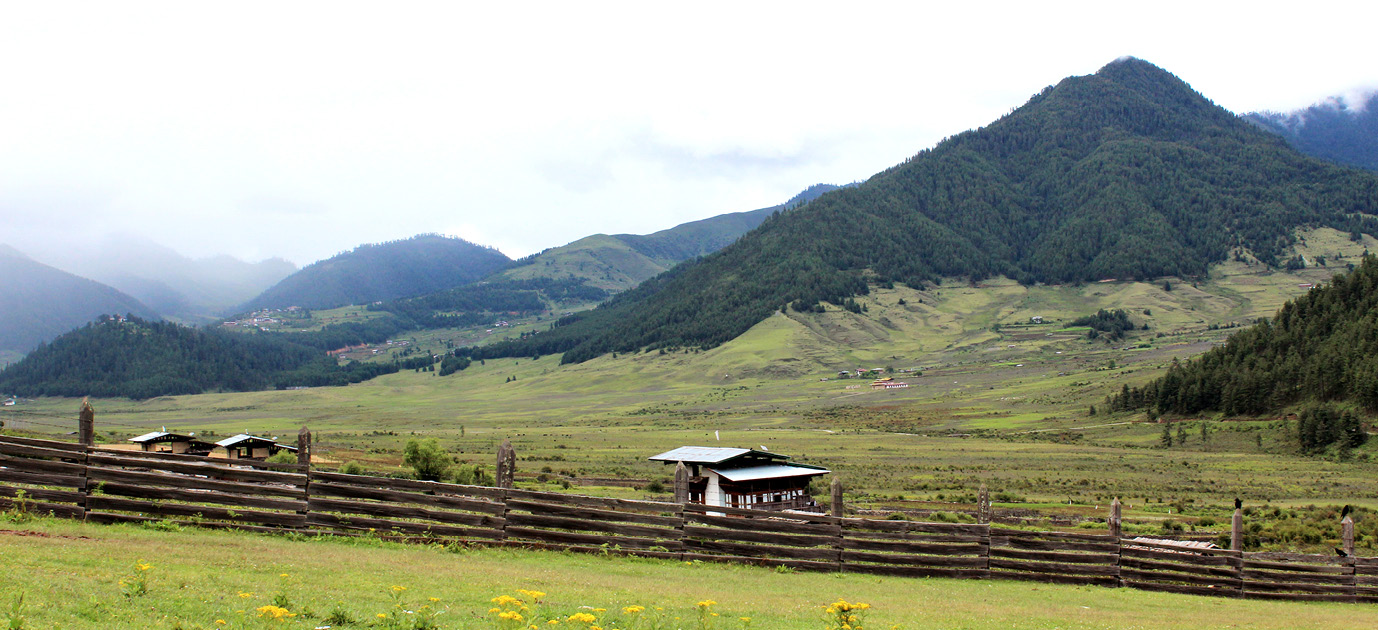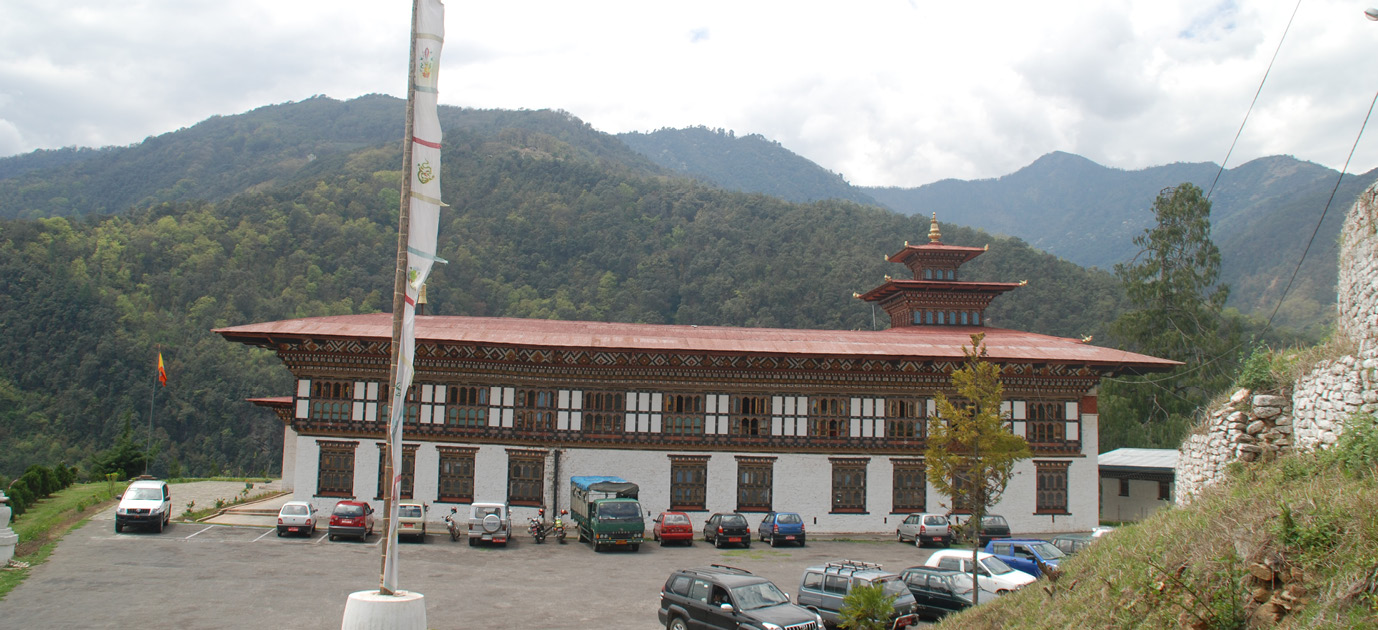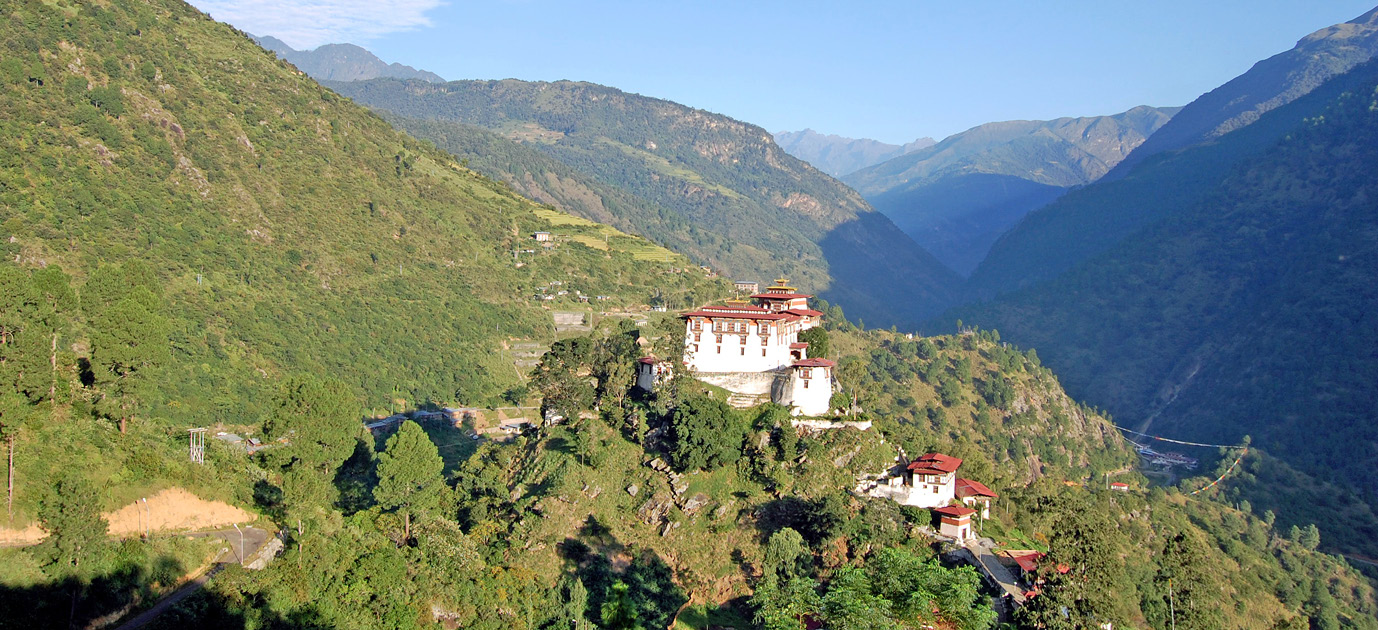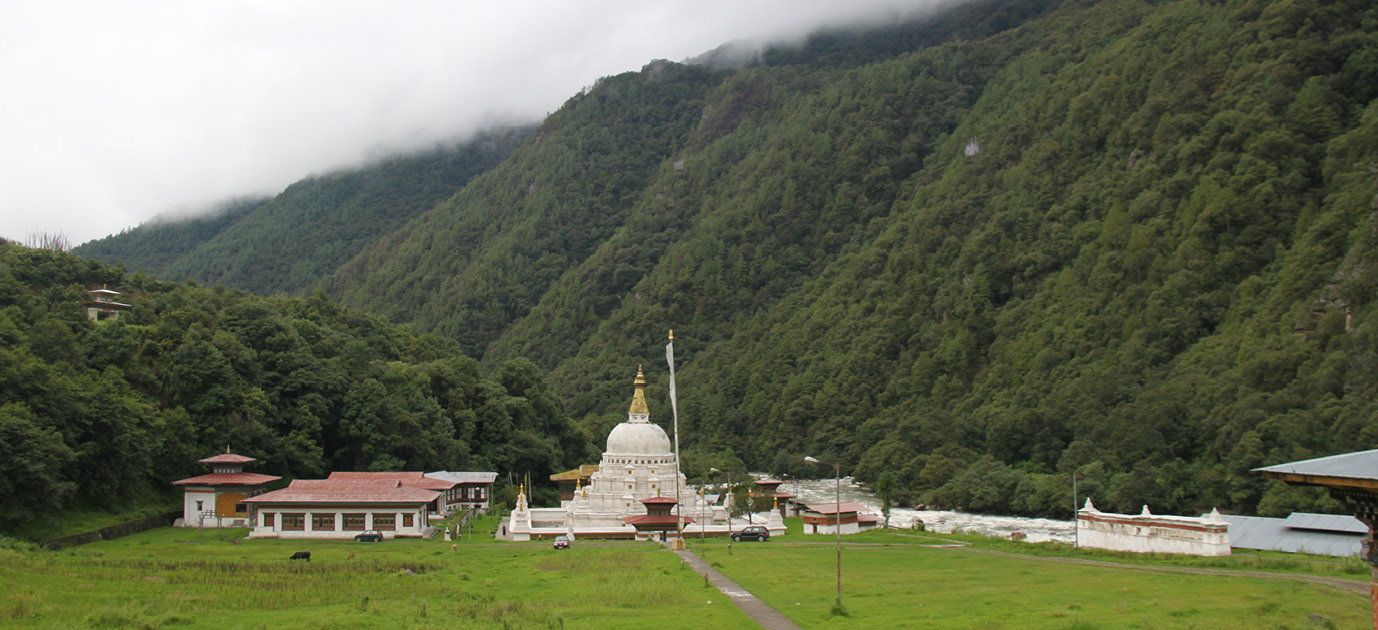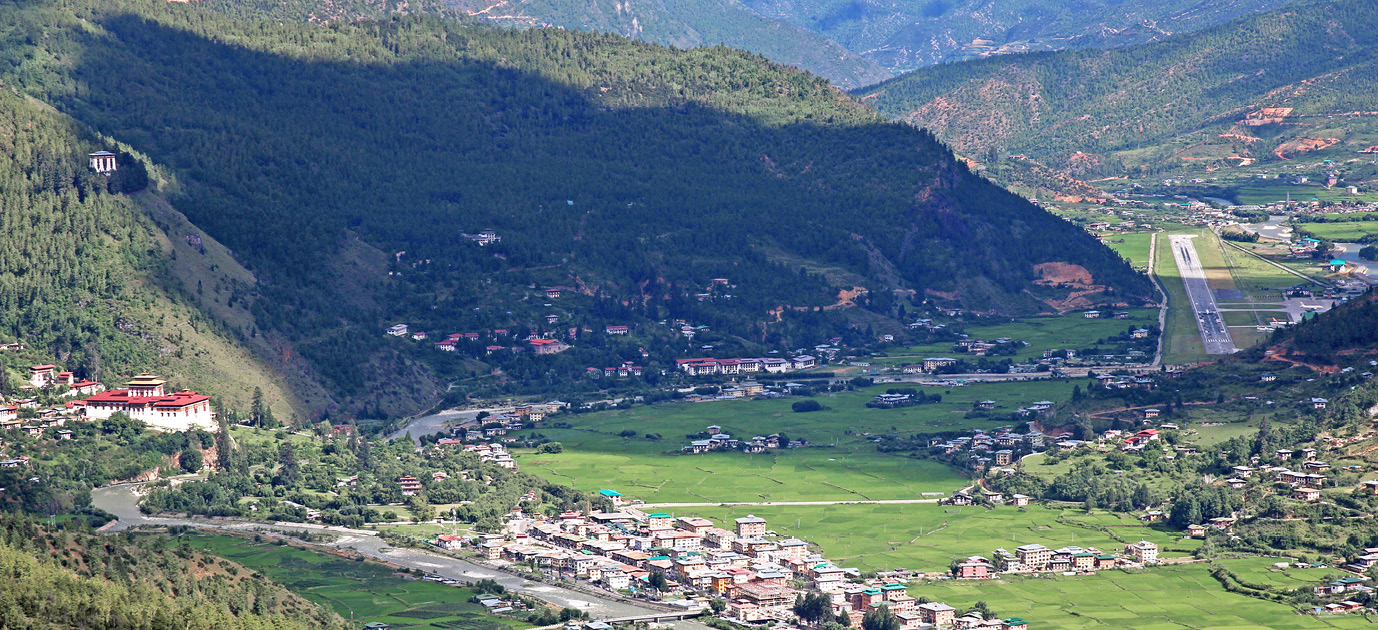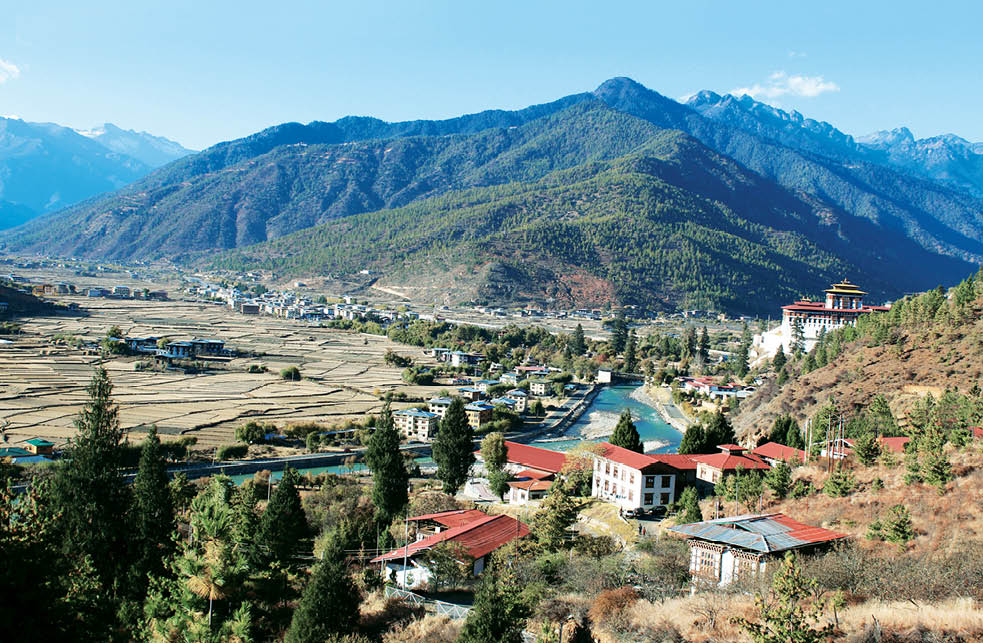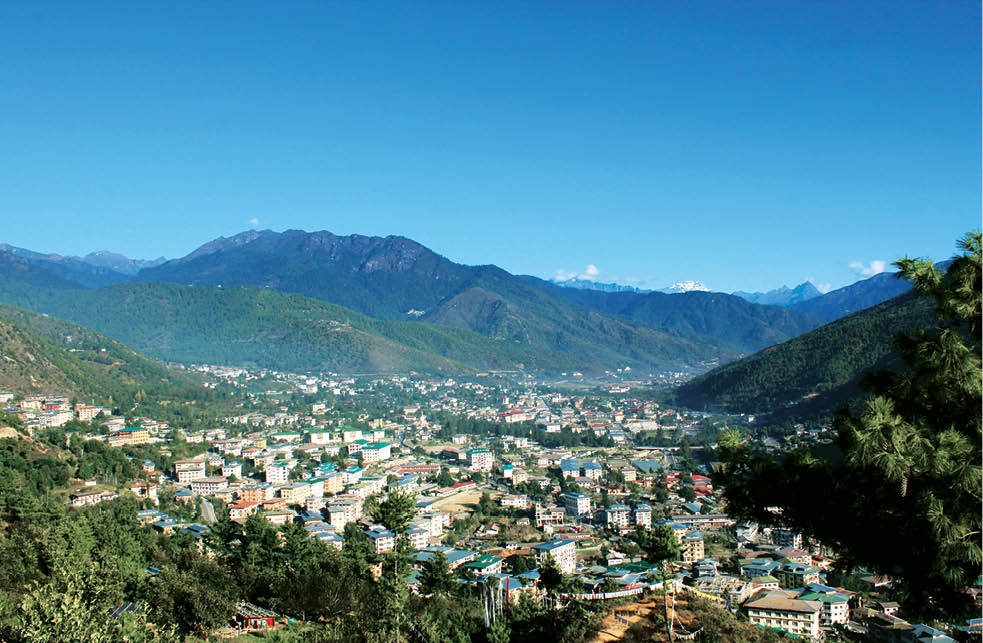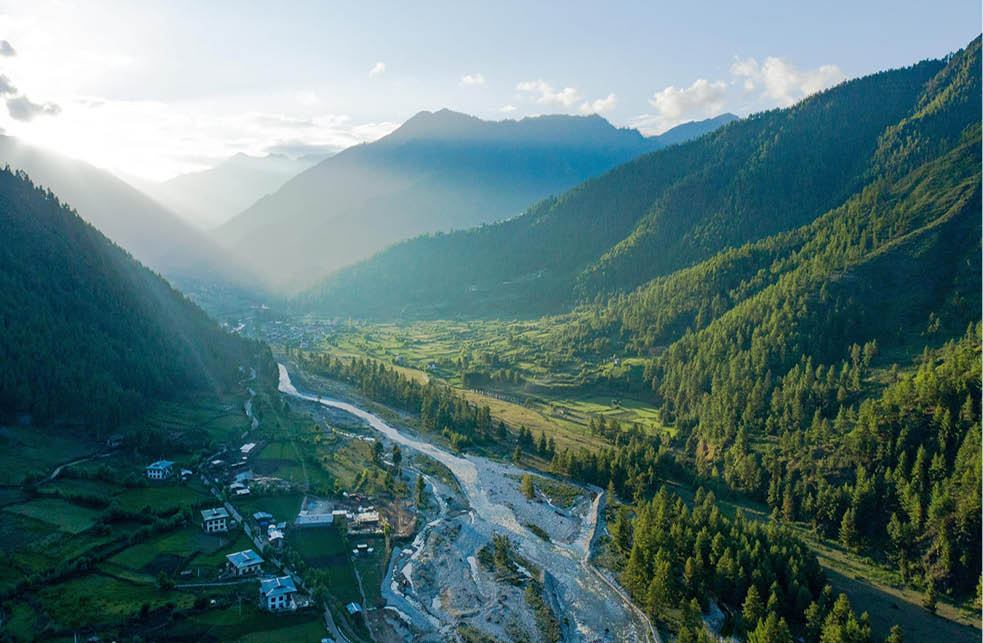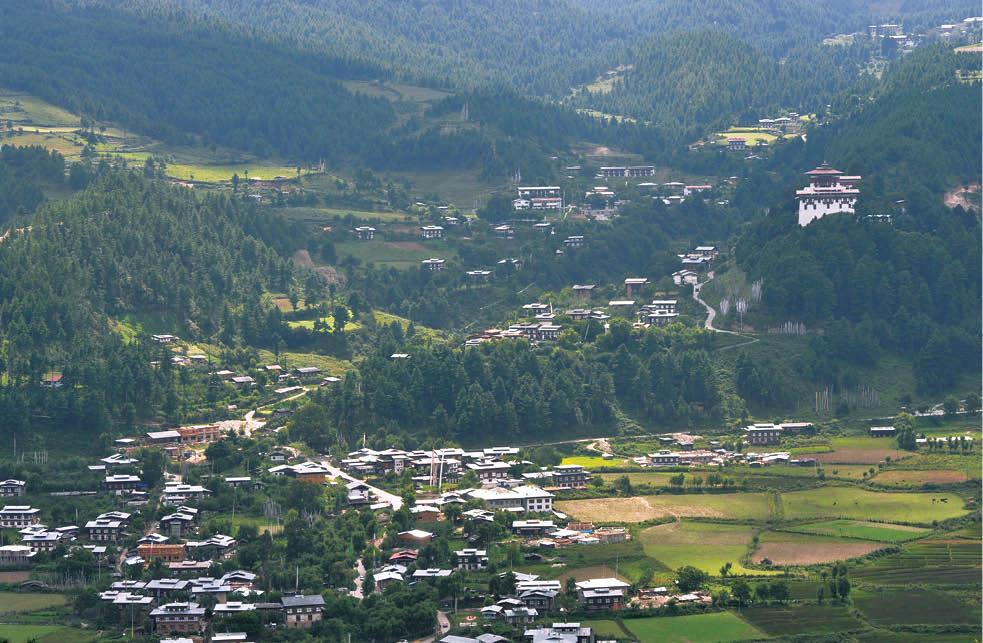


BODY MIND HAPPINESS TOUR (13 days)
Day 01: Paro and drive to Thimphu
The flight to Paro is one of the most spectacular in entire Himalayas. Whether flying along the Himalayan range from Kathmandu, the journey offers fascinating views and an exciting descent into the Kingdom. Bhutan’s first gift, as you disembark from the aircraft will be cool, clean fresh mountain air. After immigration formalities and baggage collection, you will be met by our representative, and afterwards drive to Thimphu, En route visit Simtokha Dzong, the oldest fortress of the country constructed by Zhabdrung Ngawang Namgyel in 1629. The name Simtokha literally means ‘Atop a Demon’ and the legend associated with the dzong’s construction tells us that it was built in order to subdue an evil spirit that was harassing travelers in the region. Overnight hotel in Thimphu.
Day 02: Thimphu – Punakha
After breakfast, drive up to Dochu-la pass (3,088m/ 10,130 ft) stopping briefly here to take in the view and admire the chorten, mani wall, and prayer flags which decorate the highest point on the road. If skies are clear, the following peaks can be seen from this pass (left to right): Masagang (7,158m), Tsendagang (6,960m), Terigang (7,060m), Jejegangphugang (7,158 m ), Kangphugang (7,170 m ), Zongphugang (7, 060 m ), a table mountain that dominates the isolated region of Lunana – finally Gangkar puensum, the highest peak in Bhutan at 7,497m.
After Lunch on the way to Punakha Dzong embark on a short walking excursion to Chimi Lhakhang, located on a ridge surrounded by beautiful paddy fields. From road point, it takes about 10-15 minutes walk through Sobsukha village to reach the monastery. Also known as Fertility temple, it is associated with Lama Drukpa Kuenley, popularly known as ‘Divine Madman’. It is widely believed that couples who do not have children and wanting one, if they pray at this temple, they are usually blessed with a child very soon.
After that drive to Punakha dzong which was former capital of Bhutan and seat of the Government until 1955 when the capital was moved to Thimphu.Visit Punakha Dzong or ‘Palace of Great Happiness or Bliss, built at the junction of the Phochu and Mochu rivers in 1637 by Shabdrung Ngawang Namgyal. This majestic dzong served as both the religious and the administrative center of Bhutan in the past. It measures some 600 by 240 feet and has a six-story, gold-domed tower. Inside are courtyards and religious statuary that hint at the depth of history and spiritual tradition embodied here. Your guide will illuminate your understanding of this intricate culture that is exotic, though long established here Overnight hotel, in Punakha.
Day 03: Thimphu – Bumthang via Phobjikha valley (2320m)
After breakfast, drive towards Bumthang via Wangdue Phodrang Dzong dramatically located on the spur of a hill at the confluence of the Tsang Chu and Dang Chu rivers. Then a gradual climb goes into the valley of Gangtey (Phobjikha). There is an old monastery of Gangtey Gompa dating back to the 17th century. A few kilometers past the Gompa on the valley floor are the fascinating valley of Phobjikha. The gentle sloping hillsides of Phobjikha are described as “the most beautiful valley in the Himalayas”.
Further drive to towards the Bumthang via Trongsa.The drive to Bumthang is about six hours crossing over Pelela Pass (3,300 m) and Yotongla Pass (3,400 m). The road climbs steadily passing through semi-tropical vegetation and then to Pelela Pass(3,300m) with an alpine environment of rhododendrons and dwarf bamboo. This pass is traditionally considered the boundary between west and east Bhutan. If the weather is clear, particularly the peak of Jhomulhari (7314 m) to the west can be spotted. En-route cross Chendebji Chorten built to suppress a demon. After lunch, go out to view the impressive Trongsa Dzong, ancestral home of the ruling dynasty. In olden days the Dzong commanded the passage between east and West Bhutan.Drive further to Bumthang climbing up to Yotongla Pass and then to Chumbi Valley and to Bumthang.Overnight hotel in Bumthang.
Day 04: Bumthang sight seeing
After breakfast your sightseeing includes the Visit to the Jambay Lhakhang the oldest temple Built by king of Tibet Thritsong Desen in 7th Century, It is supposes to have built around 108 temple in Himalaya in one day to subdue the gaint demon.After that visit the Kurjey Lhakhang the Temple where Guru Rinpoche second Buddha left his body print on the rock.Guru Rinpoche visited the Bumthang under the invitation of Sindu Raja. After that walk take short hike crossing the Suspension bridge and then visit the Tamshing lhakng built by Terton Pema Lingpa and then to Konchosum Lhakhang.After lunch visit the Mebar Tsho Buring Lake which Pemalingpa discover the treasure from the lake that drive back to the town and then to the hotel. Overnight hotel in Bumthang.
DAY 5: BUMTHANG – MONGAR
The journey to Mongar takes about 6 hours with spectacular views en route. Drive through Ura village before climbing sharply to the highest point on Bhutan’s road network, Thrumshing-La Pass (4,000m). From here, the road gradually passes through picturesque alpine valleys, pine forests, maize fields and hamlets to reach Mongar town. Visit Mongar Dzong, built in the 1930’s using the traditional process without either plans or the use of nails. Overnight hotel in Mongar.
Day 6: MONGAR-LHUNTSHE
Takila Guru Statue: The world’s largest statue Of Guru Padmasambhava, with the total height of 173 feet, stands imposingly on the Takila mountain slope, which is one of the most beautiful scenic spots in Lhuntse district, overlooking the entire valley of Tangmachu. Belonging to the Tangmuchu community, an old monastery (Lhakhang) exists at the site of Guru Statue. Lhuntse Dzong: This mighty fortress, popularly known as Lhundub Rinchentse sits upon a hill overlooking the Kurichu River. Khoma Village: This village is known throughout the country for its signature woven textile, the Kishuthara. The women sit in a row of makeshift textile cottage, weaving intricate designs and patterns. Picking up a Kishuthara here will be much cheaper than buying it from one of the handicraft shops in the capital. Over night hotel in Lhuntshe.
DAY 7: LHUNTSHE-TASHIGANG
After breakfast drive to Tashigang. On the way Drametse Lhakhang, a sixteenth-century monastery straddling a steep and narrow mountain ridge in the verdant slopes of the eastern Himalayas, today houses a community of 80 monks. This Nyingma Buddhist site predates the seventeenth-century consolidation of Bhutan into a single kingdom. Trashigang Dzong: It was built in 1659 to defend against Tibetan invasions. This imposing fortress is strategically situated high atop a spur overlooking the Dangmechu River.
Day 08: Day excursion to Tashi Yangtshe.
Today will take a day excursion to Trashiyangtse and on will stop at Gomphu Kora one of the popular places in eastern Bhutan which is blessed by Guru Rinpoche. After that will continue to Trashiyangtse and on reaching Trashiyangtse will visit Chorten Kora which is similar to the
Boudhanath stupa in Nepal. After that will spend some time in Trashiyangtse town which is unique in Bhutan as all the buildings in this town are of traditional architecture.
If you wish to visit Rignay School, an institute for Traditional Arts and Crafts will take you there. Then will drive back to Trashigang.over night hotel in Tashigang.
Day 09: Trashigang sightseeing
Day excursion to Rangjung Monastery: Rangjung Woesel Choeling Monastery is located in Eastern Bhutan under Trashigang district at Rangjung. The monastery was founded by His Eminence Dungsey Garab Dorje Rinpoche in the year 1989 with few monks and nuns. It has a flourishing community with branches monasteries and retreat centers.
Radhi village is famous for two things, its rice fields and the skill of its weavers. It is often known as the ‘Rice Bowl of the East’ because of its verdant rice fields that supply most of the grain to eastern parts of the country. Lunch with locals at local farm house.Over night hotel in Tashigang.
Day 10: Trashigang to Paro (fly-out)
Drive to Yongphula Domestic airport and depart to Paro. Upon aririval at Paro, after lunch visit Paro Dzong, ‘Fortress on a Heap of Jewels’, is ranked one of the best Bhutanese architecture.The Dzong also offers administrative seat of the district of Paro. The Dzong was built in 1644 under the order of Zhabdrung Ngawang Namgyal. Ta Dzong unique national museum: Perched above Paro Dzong it was watchtower built in 1649 to protect the undefended Paro Dzong located below, renovated in 1968 to house the National Museum. Today this museum houses the best collections of all time historical items making worth for a visit. Enjoy outdoor activities wearing Gho/Kira, play archery. Explore the Paro tiny town: Tiny Paro town actually can offer lot more, there are many authentic handicraft shops, readily available Bhutan made products, grocery and imported garment shops beside having many small restaurants around. Overnight hotel in Paro.
Day 11: Paro-Haa Excursion 6 hrs
After Breakfast drive to Haa Valley.On the way Dzongdrakha Temple.It is situated on the western region of Paro Valley on the Cliffside and often referred as “Mini Taktsang” of Bhutan. Tucked in a cliff above Bondey village, visit to temple offers pictorial hikes and one of the must visit places in Paro for inquisitive guests while in Paro. Chelela Pass at 3988m: Highest motor-able road pass connecting two districts Paro and Haa, an elevation of 3988m above the sea level. On clear days, one can enjoy view of the most sacred Mt. Jomolhari (7314m). The pass is dotted with beautiful prayer flags and offers amazing walks around, From the roadside near Chele La, it takes about 40 mins to climb about 300m. Overnight hotel in Paro.
Day 12: Hike to Tiger’s Nest.
After breakfast excursion to Taktshang Monastery (approx. 5 hours round trip walk): It is one of the most famous of Bhutan’s monasteries, perched on the side of a cliff 900m above the Paro valley floor. It is said that Guru Rinpoche arrived here on the back of a tigress and meditated at this monastery and hence it is called ‘Tiger’s Nest’. This site has been recognised as a most sacred place and visited by Zhabdrung Ngawang Namgyal in 1646 and now visited by all Bhutanese at least once in their lifetime. The hike to the monastery makes a splendid half day excursion. Overnight hotel in Paro.
Day 13: Depart Paro
After Breakfast drive to Air Port and Depart to Your Destination.
Tashi Delek.



